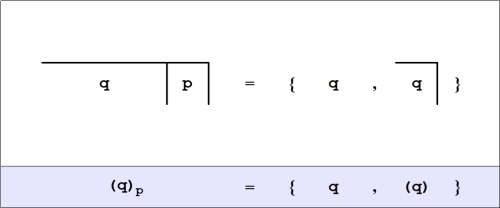Another tactic I tried by way of porting operator variables into logical graphs and laws of form was to hollow out a leg of Spencer Brown’s crosses, gnomons, markers, whatever you wish to call them, as shown below.
The initial idea I had in mind was the same as before, that the operator over would be counted as absent when
evaluates to a space and present when
evaluates to a cross.
However, much in the same way operators with a shade of negativity tend to be more generative than the purely positive brand, it turned out more useful to reverse this initial polarity of operation, letting the operator over be counted as absent when
evaluates to a cross and present when
evaluates to a space.
So that is the convention I’ll adopt from this point on.
cc: Cybernetics (1) (2) • Peirce (1) (2) (3) (4) (5) (6) (7) (8) (9) (10) (11) (12) (13) (14)
cc: Ontolog Forum (1) (2) • Structural Modeling (1) (2) • Systems Science (1) (2)
cc: FB | Logical Graphs • Laws of Form


Pingback: Survey of Animated Logical Graphs • 2 | Inquiry Into Inquiry
Pingback: Survey of Animated Logical Graphs • 2 | Inquiry Into Inquiry
Pingback: Survey of Animated Logical Graphs • 3 | Inquiry Into Inquiry
Pingback: Differential Propositional Calculus • Discussion 4 | Inquiry Into Inquiry
Pingback: Animated Logical Graphs • 67 | Inquiry Into Inquiry
Pingback: Animated Logical Graphs • 68 | Inquiry Into Inquiry
Pingback: Survey of Animated Logical Graphs • 4 | Inquiry Into Inquiry
Pingback: Survey of Animated Logical Graphs • 5 | Inquiry Into Inquiry
Pingback: Survey of Animated Logical Graphs • 6 | Inquiry Into Inquiry
Pingback: Survey of Animated Logical Graphs • 7 | Inquiry Into Inquiry